 Quite a cold snap at the moment, so a good time to get out around my alternative local patch Brierley Forest Park and make sure the feeding stations are well stocked.
Quite a cold snap at the moment, so a good time to get out around my alternative local patch Brierley Forest Park and make sure the feeding stations are well stocked.Plenty out and about there, although the transient winter finch flocks, Redpoll and Siskin have moved on. Blackbird numbers are notably high with loose gatherings of 20 birds in several areas. Most gratifying birds to see, however, were Willow Tits, with 4 or 5 individuals congregating around the seed pots and hanging fat feeders.
The recent story of the Willow Tit is shocking both for the extreme decline in their numbers and for the lack of awareness of it. Just take a look at what happened to them in Kent. In 1996 there was estimated to be 500-900 pairs in the county, and now, it's probably none. There's a similar story over most of the south-east, East Anglia, much of Wales, indeed few are the regions in which they are not crashing or already extinct- Nottinghamshire/Derbyshire probably being their stronghold these days.
It may be that the very similar Marsh Tit, declined significantly itself since 1960's although probably levelling off now, provide the sort of ID confusion that lead birders to think there are Willows present in areas where they have lately disappeared from. The best way to tell between them is their call ( try listening at the RSPB website) - although even those can vary enough to be confused, and the slight plumage details aren't always sure fire either. General advice is to look for a slight wing-bar on the Willow Tit.
The national figures say it all really, a decline of 72% in the years 1994-2002, nearly three quarters gone in only eight years! Little wonder it was recently added to the Red List of species of greatest conservation concern.
There is still much debate over the cause of this catastrophic dip. The Willow Tit's weakness is its choosiness, only very wet young plantations of willow, birch and alder scrub, and occasionally pine, will do, so on sites where plantations are maturing, drying up or are being cleared of scrub, Willow Tits suffer quite badly. One influence on this change is the national boom in deer populations, Roe and Muntjac in particular will nibble away the undergrowth these birds rely upon. Coupled with general habitat loss to development and urban sprawl, and Willow Tits are running out of breeding sites.
The other theory that's given a lot of credence proves how difficult biodiversity can be to manage. Despite having an abominable 2007 when the heavy rains washed away all their caterpillar food, Blue Tits are generally on the increase in areas where Willow Tits are losing out. The evidence suggests to some that Willow Tits, the only tit species in Britain to excavate its own nest cavity, are muscled out of their territories and nest sites by the other tits. Mainly Blue Tits, but also Marsh and Great Tit will do this. Great Spotted Woodpecker are another additional pressure, as they will raid nests for chicks.
Studies are ongoing and we don't really have any answers just yet, and I'd suppose there won't be just one reason for the crash. I tend to wonder about the future and climate change. With dryer summers degrading their habitat further, more competitor species making it through milder winters, the future looks bleak for the Willow Tit, real into oblivion stuff.
Thankfully we still have them locally, chiefly due to all the old colliery sites around here that have been returned to nature and planted up in the last 20 years, sites such as Brierley.
They are also present at Carsington, and I'm volunteering there tomorrow. I just might begin adding Willow Tit to the conservation spiel I give to visitors.



No comments:
Post a Comment